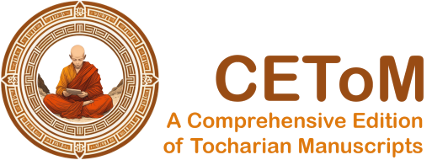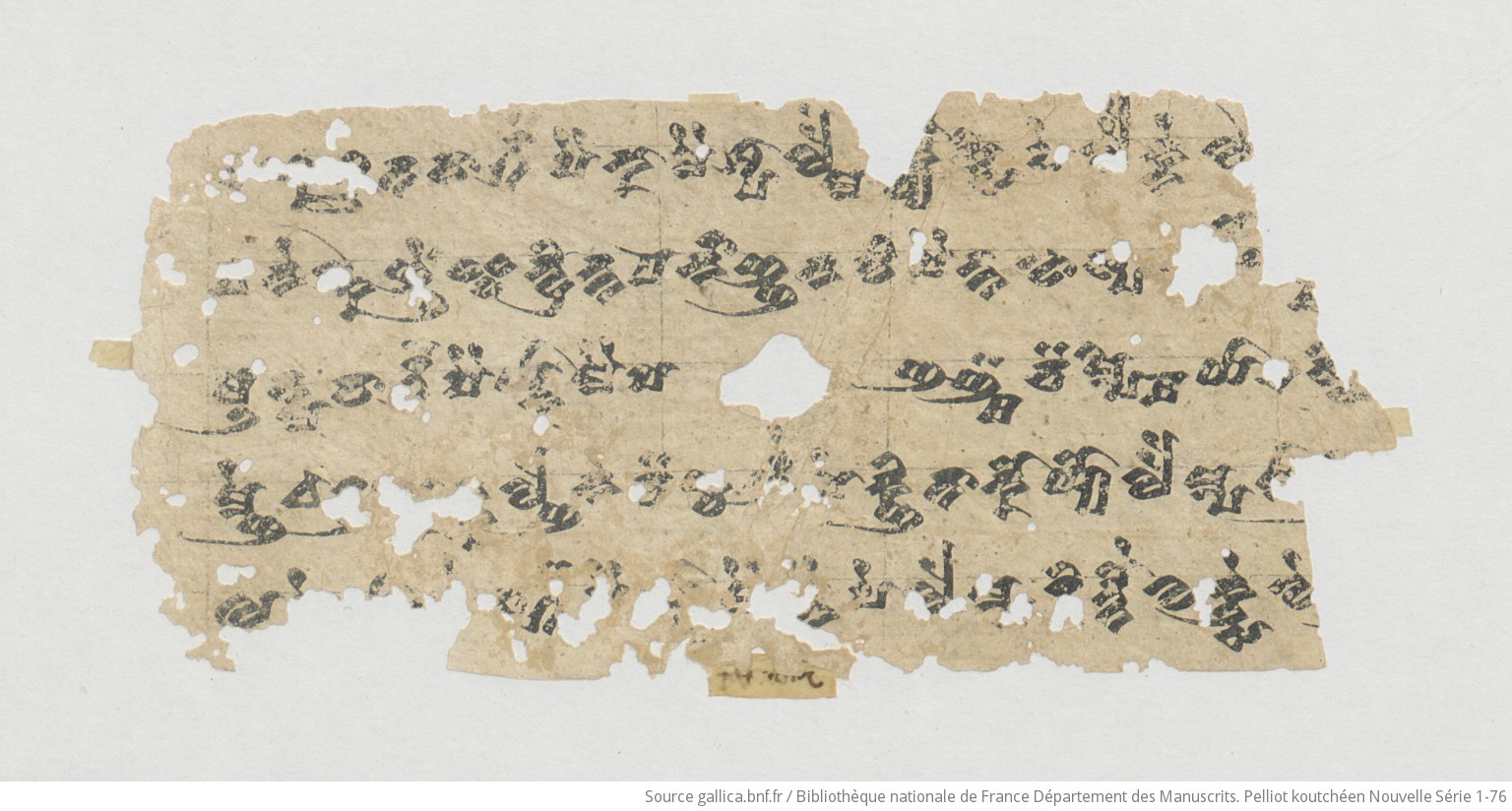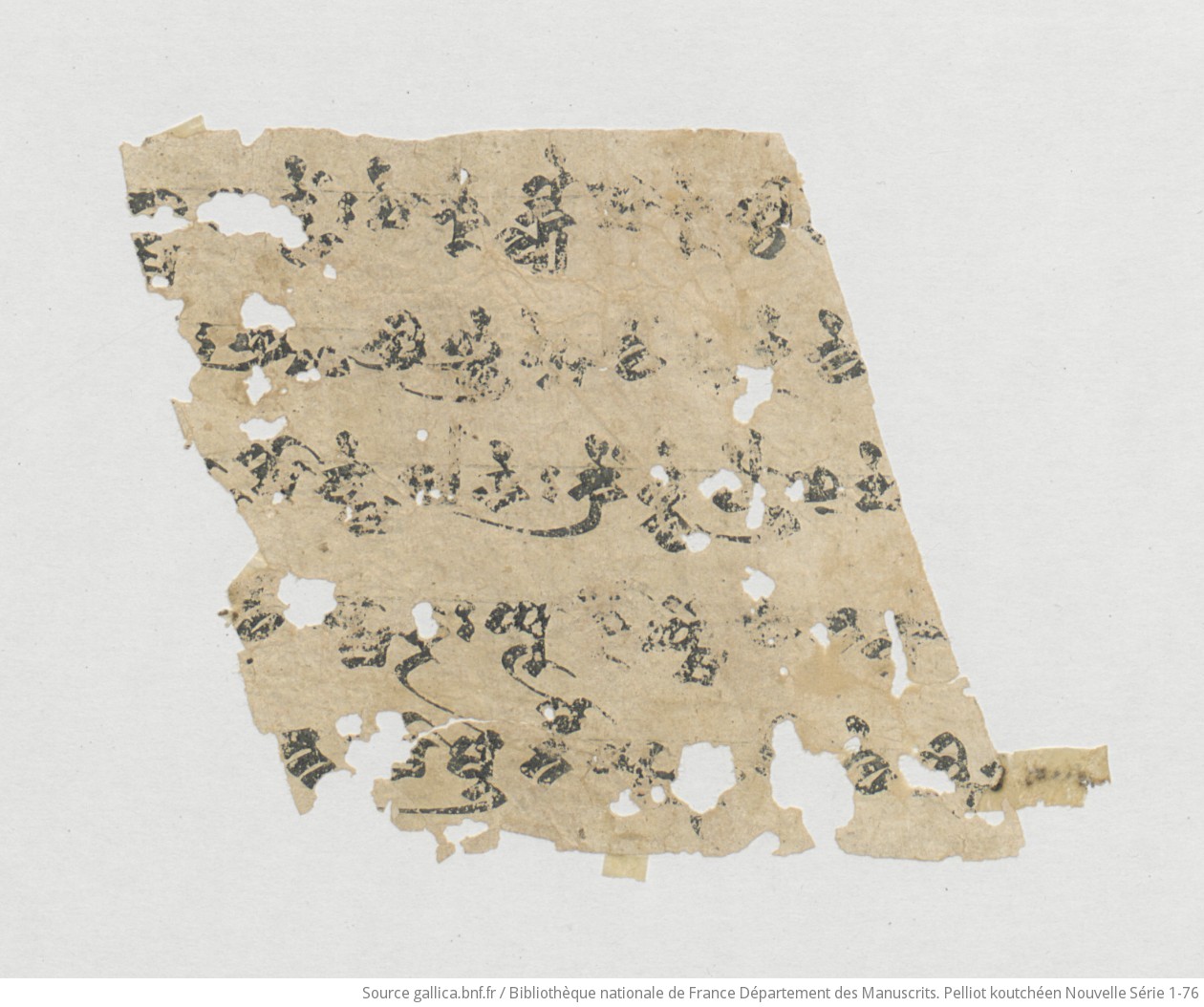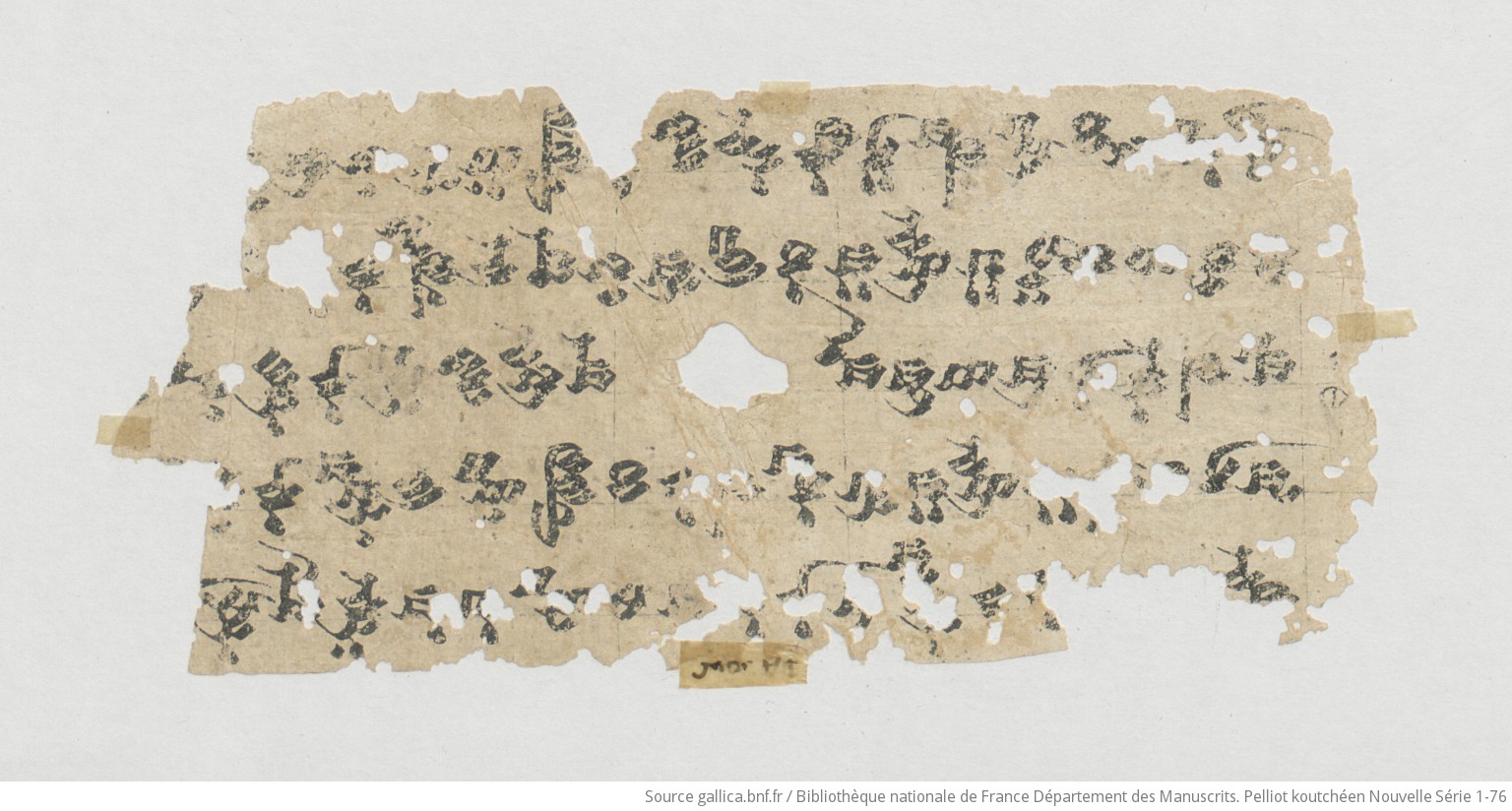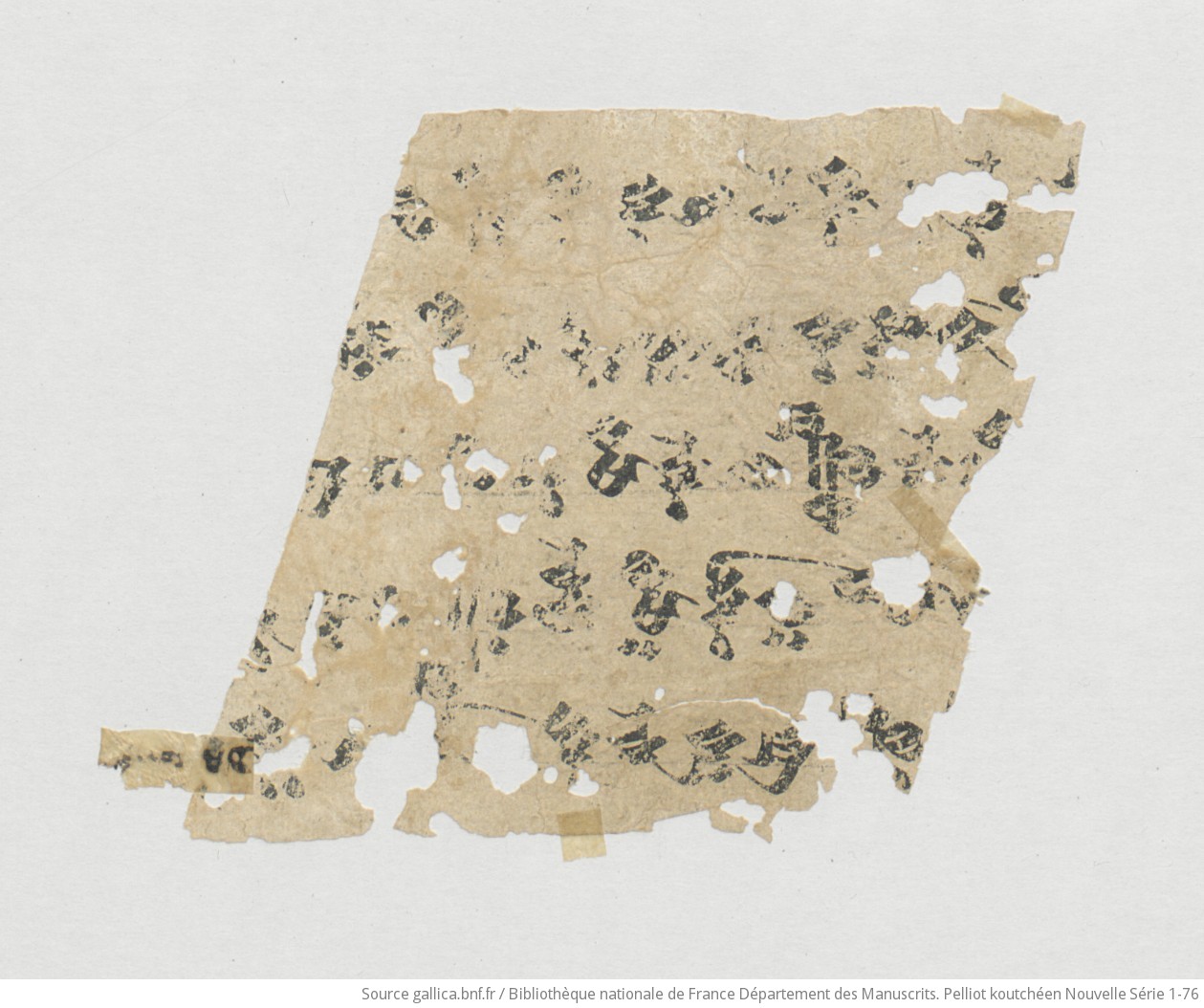Work in progress
PK NS 25 and 26
| Known as: | PK NS 25 and 26; Pelliot Koutchéen Nouvelle Série 25; Pelliot Koutchéen Nouvelle Série 26 |
|---|
| Cite this page as: | Georges-Jean Pinault; Melanie Malzahn (collaborator). "PK NS 25 and 26". In A Comprehensive Edition of Tocharian Manuscripts (CEToM). Created and maintained by Melanie Malzahn, Martin Braun, Hannes A. Fellner, and Bernhard Koller. https://cetom.univie.ac.at/?m-pkns25and26 (accessed 02 Jul. 2025). |
|---|
Edition |
| Editor: | Georges-Jean Pinault; Melanie Malzahn (collaborator) |
|---|
| Date of online publication: | 2013-08 |
|---|
Provenience |
| Main find spot: | Duldur-akur |
|---|
| Specific find spot: | DA, cour |
|---|
| Expedition code: | DA cour + DA y1 |
|---|
| Collection: | Bibliothèque nationale de France, fonds Pelliot Koutchéen (Paris) |
|---|
Language and Script |
| Language: | TB |
|---|
| Linguistic stage: | classical |
|---|
| Script: | classical |
|---|
Text contents |
| Title of the work: | Udānastotra |
|---|
| Passage: | 29a-33d [shorter version] |
|---|
| Text genre: | Literary |
|---|
| Text subgenre: | Doctrine |
|---|
| Verse/Prose: | verse |
|---|
| Meter: | 43434 (4x) |
|---|
Object |
| Material: |
ink
on paper |
|---|
| Form: | Poṭhī |
|---|
| Size (h × w): | 8.2 × 25.9 cm |
|---|
| Number of lines: | 5 |
|---|
| Interline spacing: | 1.5 cm |
|---|
Images
Transliteration
| lf | 80 [2] |
|---|
| a1 | [20] 8 [ś]ru ta vā rgä pai kā mai śpā lmeṃ kly[au] ssi pe lai kne o [kt]mā [n]· ntseṃ : ṣe ke klyau ṣo re ñcī /// |
|---|
| a2 | e ne ṅkā ññeṃ i ndri nta pa rnā ñña na vi ṣai nta au spa – [rso](·) [m]a : ñ[i]¯ ¯ś ñi ññe ṣṣe wä nta re we /// |
|---|
| a3 | ā tma vā rgä pai ykā mai ṣa ○ ña¯ ¯ñmä cä mpi¯ ¯m yā [ta] ssi po cme la ne : kreṃ twe lñe¯ ¯ś ṣe /// |
|---|
| a4 | mñe e [ru] [:] [pu] [tk]a lñe ne cä ñca rñe ṣe kñi tā ko yyo lai mpa mā (·)[ri] [w]o yma¯ ¯r• : yū ko¯ ¯ymä [w](·) ta kl(·) /// |
|---|
| a5 | 30 (·)e (·)[ā] [l]a vā rgä [p]ai [y](·)ā mai [s]nai pe le m[p]a ri ttau wa kuse we(·) [ñ](·) nta [:] mā ā rto yma¯ ¯r [mā] we ñi¯ ¯mä /// |
|---|
| b1 | lk(·) (– –) (·)[ne] n(·) [st]mau [p]rā [k]re (·)e(·) ma śa yi¯ ¯m ṣe me kauṃ sū śau¯ ¯[l] (–) lme(·) mā no ka nte (–) [k]ul(·) [s]a [s]nai /// |
|---|
| b2 | mi tra [vā](·) [gä] [p]ai ykā mai po cme l[a] ne ka llo ymä wā ṣmoṃ kre [nta]ṃ [ku] śa¯ ¯[l] wä ntre śwä tkā ly(·)e ai śau m(·)[e] /// |
|---|
| b3 | mpa la rau [ñ]e mā ya mī ma¯ ¯r ○ mu skā tsi śpo kre ntau naṃ¯ ¯[t]s : ka lymi sa ke śta [ṣ]e ñca pa pā /// |
|---|
| b4 | ni rvā ṇa vā¯ ¯rgä pai ykā mai ce wyā mo rsa a kā lkse ne(·) (·)e[¯] [¯k] (·)[ñ]ī ta¯ ¯rñä ne rvā [ṇ]ä ṣṣai ri nts· ñi /// |
|---|
| b5 | [ñ]ñe [ṣ]ṣe sa¯ ¯k śpā lme[ṃ] trai kle ṅke ntsa [ka] llo yeṃ [p]o saṃ sā(·) (·)[ṣi] kau [ṣe] ntai ra sa naṃ [n]ne [snai] m[ī] /// |
|---|
Transcription
Translation
| a1 | I have written the Śrutavarga, the excellent one in order to hear the Law consisting of eighty thousand parts. May I (seize) [it] at the first lecture [lit. hearing] [and] (may I teach [it] to others without flaw (?) while going into mission.) |
|---|
| a2 | May I understand clearly the internal senses [and] the external objects, (may I take) the thing belonging to my own as [meaningless as] mere sound [and] may I not cling [to it]. 29. |
|---|
| a3 | I have written the Ātmavarga: May I be able to tame myself in all births, al(ways desirous) of good speaking, having evoked the (incli)nation (to be close to the good ones!) |
|---|
| a4 | May I have always pleasure in sharing, may I not be mixed with an evil one! |
|---|
| a4+ | May I win the battl(e with the passions, with the deaths, with the elements [= skandhas], and with Māra.) |
|---|
| a5 | 30. I have written the Peyālavarga. The talks that are connected with Lawlessness may I not approve [of them], may I not speak [them], |
|---|
| a5+ | (may I apply my) ze(al to the speech of the Buddha, to the Śāstras!) |
|---|
| b1 | Being installed firmly on the (La)w, even if I live only one single day, that [would be] an (exce)llent life. (May I not adopt a life) during a hundred years connected with (Lawless)ness. (31.) |
|---|
| b2 | I have written the Mitravarga. May I obtain in all births good friends! May I have company [lit. coming together] (with the) wise one that is resolute about the good thing! |
|---|
| b2+ | (May I not make) friendship with (the bad one) [which would result in] the disappearance of all virtues! |
|---|
| b3 | May the one who evaluates rightly, (striving) towards the obser(vance, become my friend! 32.) |
|---|
| b4 | I have written the Nirvāṇavarga. Through this deed may my wish be fulfilled for sure! May I my(self open with the two hands of the four truths the door) of the city of Nirvāṇa, |
|---|
| b4+ | may all the beings of the Saṃsāra reach through the three vehicles the excellent happiness consisting in (extinction)! |
|---|
| b5 | (May I be always) without ha(rm) even against a killing enemy (in all births! 33.) |
|---|
Commentary
Parallel texts
Remarks
| * | Two joining fragments; there are direct joints in all lines. The size given above is that of the two combined. Of the leaf number only a few strokes are visible. |
|---|
| n1 | Direct joint of fragments between o- and -ktmān. |
|---|
| n3 | Direct joint of fragments between kärsoym and ñiś. For ñiññeṣṣe wäntare there is a variant in PK AS 5B. |
|---|
| n5 | Direct joint of fragments between yātässi and po. |
|---|
| n7 | Direct joint of fragments between tri- and woymar. Lévi 1933 supplements mā (ritto)ymar because of ymar in PK AS 5C, Thomas excludes to there. A simple ri is not possible here either. Thomas reads [w·], and so do we, therefore mā (t)[ri][w]oymar. |
|---|
| n8 | Direct joint of fragments between welñe and nta. |
|---|
| n9 | Direct joint of fragments between śaul and (śpā)lme(ṃ). |
|---|
| n10 | Direct joint of fragments between krentäṃ and kuśal. källoymä, like śayim in b1, might have virāma with a very short stroke beneath the sign - not here, but in the original copy of the text. The same is true for b3, where there is a short stroke towards the lower mar in yamīmar, in b5 (sak) and in a4 (yūkoymä). |
|---|
| n13 | Direct joint of fragments between krentaunaṃ and ts. |
|---|
| n14 | Direct joint of fragments between kñ- and -ītärñ. |
|---|
| n15 | Direct joint of fragments between saṃsārṣ- and -ṣi. |
|---|
Philological commentary
| n2 | The adjective eneṅkāññeṃ has a masculine form even though it is constructed with the alternant plural form indrinta, which requires a feminine plural adjective like in the antonym pärnāññana. Note that in the parallel PK NS 24 a 2 we have eneṅkāmeṃ, which is an adverb based on the adverb eneṅka. Apparently, the two copyists had alternative strategies for avoiding a problem with this passage in the archetype. The original text ought to have had eneṅkāññana= ndrinta with a sandhi form of indrinta. The text alteration then seems to have started by reintroduction of the i-vowel. |
|---|
| n4 | Note the direct translation of ātman- by ṣañ añm. |
|---|
| n6 | Here we have rmamñe eru – the parallel text PK AS 5B b 6 confirms this – instead of rmamñ= erīmar with regular sandhi in the parallel text PK NS 24 b1. As a matter of fact, rmamñ= erīmar is more consistent with the repetitive use of optative forms in this text and it shows regular sandhi. Since the sequence with hiatus is odd for a metrical passage, one would assume that rmamñ= erīmar is more original. |
|---|
Linguistic commentary
| n11 | The parallel versions PK AS 5C a 3 and PK NS 24 b 4 have mā no kante pikwala instead of mā no kante pikulasa. The first formulation is probably more original because it shows the extension value of the oblique ("during 100 years"). It has been replaced by the alternative espression with the perlative that implied the alternative plural pikula in order to keep the metre. |
|---|
| n12 | Note that here we have singular forms instead of plural forms like in the parallel version PK AS 5C. The scribe there did probably interpret the singular tākoy-ñ as the late allegro-plural form tākoyeṃ-ñ. |
|---|
References
other
Lévi 1933: 61-63; Thomas 1966a: 174-176; Pinault 1990a: 62
Bibliography
Lévi 1933
Lévi, Sylvain. 1933. Fragments de textes koutchéens. Udānavarga, Udānastotra, Udānālaṁkāra et Karmavibhaṅga, publiés et traduits avec un vocabulaire et une introduction sur le «tokharien». Paris: Imprimerie Nationale.
Pinault 1990a
Pinault, Georges-Jean. 1990a. “Compléments à l’Udānālaṅkāra et à l’Udānastotra en koutchéen.” In Documents et archives provenant de l’Asie Centrale. Actes du Colloque Franco-Japonais, Kyoto, 4–8 octobre 1988, edited by Akira Haneda, 51–69. Kyoto: Association Franco-Japonaise des Études Orientales.
Thomas 1966a
Thomas, Werner. 1966a. “Tocharische Udānastotras der Bibliothèque Nationale in Paris.” Zeitschrift für Vergleichende Sprachforschung 80: 163–81.
